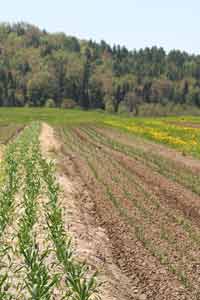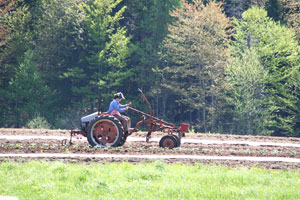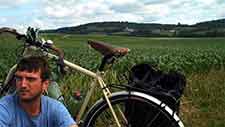Nine miles east of Marshfield, Vermont, where I had traveled to visit Wellspring Farm, I outsmarted the cold May showers with a hot cup of coffee. I was warming up at a small, rustic joint called Joe’s Pond Café when a group of men appearing to be in their mid to late 20s walked in and sat down at the end of the counter. Each one sported the quintessential Vermont uniform: flannel shirt, jeans, and work boots. In my mind, I asked them if they were modeling on a photo shoot at the local sawmill. I took a hard look at their rugged hands and decided I’d be better off minding my own business and keeping my clever questions to myself.
The old man behind the counter asked where I was biking to and from and I gave him the short story behind my cross-country excursion. Suddenly, the aspiring lumberjacks worked their way into the conversation and fired off a litany of questions.
“Do you carry a laptop?”
“Is that an iPhone?”
“How do you check your email?”
“Are you keeping a blog online?”
They were more interested in gadgets and modern conveniences than my motivations for riding my bike across the country.
After my coffee kicked in I began volunteering information about my grassroots research project on sustainable agriculture and my use of social media to share my discoveries. What started as a brief Q-and-A turned into a passionate conversation where we tossed around ideas about composting, building with recycled materials, sustainable forestry, and buying local products. But it was the oldest man of the group who had me interested in more than just a cup of hot coffee. His name was Gary, roughly 40 years old and from Montpelier, the nearby state capital.
Like many native Vermonters, Gary had sugared in the Green Mountains for more than 25 years. Historically, the sugaring season has begun in mid- to late April. However, over the years, the sugaring season has moved up an entire month to March, as late winter and early spring have become warmer. Gary claimed that the best sugaring had now traveled further north and into Canada, based on the change in climate. With sadness in his voice, Gary looked off toward a corner of the café and reminisced about when he was young and the best sugaring was found right there in Vermont. Gary turned to me and said, “It is happening. The calendar is changing.”
With Gary’s snippet of Vermonter wisdom tucked away in my back pocket, I climbed back on my bike and made my way to Wellspring Farm.
Wellspring Farm is surrounded by a landscape shaped by gentle rolling hills and the swift Winooski River. It is home to one of Vermont’s first CSA (Community Supported Agriculture) farms, where a young, fiery farmer, Mimi Arnstein, grows 5 acres of organic vegetables. Her CSA serves more than 150 families in the area with fresh produce and cultivates a community atmosphere. These families are encouraged to visit the farm in person, eat homemade wood-fired pizza, and enjoy a “pick your own” shopping spree, relishing the sun on their backs and dirt under their fingernails.
Mimi is part of the new generation of young and college-educated farmers who are opting out of the corporate world and opting in to growing food in a way that is meaningful and sustainable. After earning her BA in Sociology from the University of Michigan in 1994, Mimi went to work on Waltham Community Farm in Massachusetts where she got hooked on growing organic vegetables. She has been farming at Wellspring Farm since 2003.
This crop of new, young organic farmers—which includes Mimi—is growing at an exponential rate. Naturally, this is good news. The bad news is that America is still losing its second- and third-generation family farms at an alarming rate. So why is this happening? Mimi had a simple answer to what I felt was a complicated question. “Until we place a value on the food we eat, we will continue to lose family farms. Unfortunately, Americans have gotten accustomed to cheap food”.
There is no question that many Americans have lost touch with where the food on their dinner plate comes from. We have an entire segment of the population who has never set foot on a farm and will look you in the eye and tell you that food comes from the grocery store.
During my conversation with Mimi I used the buzzword “disconnection” to describe such behavior. Mimi was quick to acknowledge that a disconnection between the grower and consumer is certainly present, but as a society we are grappling with a much deeper, primal disconnection: between people and the soil itself.
“We have forgotten that food grows from the earth with only the help from us humans.” Mimi said.
“Part of the solution is in fact getting to know the farmer, but digging a potato and pulling carrots from the earth is truly moving for people. It’s not just about you purchasing from me. I want you to get on my farm and pick a tomato. That makes the difference.”
The CSA model is in demand and readily available in Vermont, however, across America, the concept is still new. Data collected in 2007 by the U.S. Department of Agriculture indicates that 12,549 farms in the United States reported marketing products through a CSA and that number continues to rise. Families can log on the popular website www.localharvest.org and search a database that lists more than 4,000 CSA farms nationwide. This movement has a profound impact on our food system and natural environment and farmers such as Mimi are celebrating this innovative partnership.
“One of the biggest impacts we make here as a CSA is keeping the land active and keeping people informed as to where their food comes from, while caring about the environment and one another. The way we farm is an act of supporting people that are growing their food and it truly builds a healthy community around something positive,” Mimi said with a big smile.
As the sun dipped below the serrated edge of the distant mountain tops I swatted at the black flies feasting on my flesh and asked Mimi one more question, “Are you concerned about climate change?”
She answered without hesitation, “Absolutely. The impact we humans have had on this earth has been enormous. I don’t think we can turn back the clock, but moving forward, I would like to think that we could do a better job protecting our planet. One of the essential philosophies in organic agriculture states that you must return what you take. Now it is time to pay the piper”.
Here in Vermont, I had just dipped my toes into a hotbed—or wellspring—of progressive farmers and their real-food disciples. And it felt fantastic.
Read the Unconventional Harvest series:
- On the Road to Find the Future of Food and Farming
- Grassland Organic Farm
- Wellspring Farm
- My Visit to an Amish Farm in New York
- Farm Sanctuary
- An Urban Oasis for Food
- Tantré Farm
- Conventional Dairy Farmer Art Thelen
- New Forest Farm
- A Large No-Till Organic Farm
- Melstone, Montana—Population 136
- In the Farmers Own Words
Nathan Winters rode a bicycle across America to discover first-hand why our food system had grown to be unsustainable, and to find alternative solutions. He traveled into the homes and communities of organic, conventional, urban and Amish farmers and community organizers. This ongoing series—to be posted every other Wednesday— represents select material from The Unconventional Harvest, a work in progress, by Nathan A. Winters.




